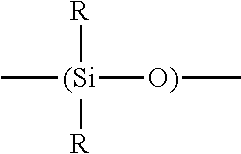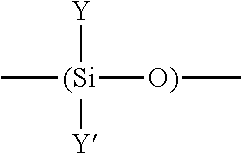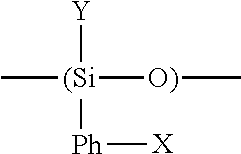Laundry detergents
a technology of laundry detergent and detergent, applied in the field of laundry detergent, can solve the problems of paradoxically being undesirable during rinsing, reducing the amount available for other possible, and not yet cleaning clothes, so as to reduce the number of rinses, save time, and reduce the level of cleaning
- Summary
- Abstract
- Description
- Claims
- Application Information
AI Technical Summary
Benefits of technology
Problems solved by technology
Method used
Image
Examples
example 1
[0177]Six percent (6%) by weight treated precipitated silica available under the name Sipernat D10 from Evonik and 1% partially hydrophobic silica available under the name R972 from Evonik are dispersed in 86.3% polydiorganosiloxane fluid having a degree of polymerisation of 65 and comprising 80 mole % methyl ethyl siloxane groups, 19 mole % methyl 2-phenylpropyl (derived from α-methylstyrene)siloxane groups and 1 mole % divinyl crosslinking groups. 6.7% by weight of a 60% by weight solution of an organosiloxane resin having trimethyl siloxane units and SiO2 units in a M / Q ratio of 0.65 / 1 in octyl stearate (70% solid) is added. The mixture is homogenized through a high shear mixer to form a foam control agent FC1.
[0178]Thirteen point five (13.5) parts of above foam control agent FC1 is mechanically mixed with 9 parts of glyceryl tribehenate provided by Oleon. The FC1 and motlen glyceryl tribehenate are mixed at 70° C. The glyceryl monobehenate and polydiorganosiloxane fluid are misc...
example 2
[0180]Another similar foam control agent FC2 is prepared, which is essentially the same as FC1, except that polydiorganosiloxane fluid is different from that in FC1. In FC2, 86.3% polydiorganosiloxane fluid having a degree of polymerisation of 65 and comprising 80 mole % methyl dodecyl siloxane groups, 20 mole % methyl 2-phenylpropyl (derived from [alpha]-methylstyrene)siloxane groups are used instead.
[0181]Fourteen (14) parts of above foam control agent FC2 is mechanically mixed with 9 parts of glyceryl tristearate provided by Oleon. The FC2 and motled glyceryl tristearate are mixed at 70° C. The glyceryl tristearate and polydiorganosiloxane fluid are miscible and the mixture has a melting point of 62° C. The mixture of glyceryl tristearate and FC2, and 4 parts of a 1% aqueous solution of Polyquaternium-10 JR 30M cationic polymer, are poured slowly into a mixer where 73 parts of sodium sulfate powder is already being stirred. The mixture is stirred continuously until a granular par...
example 3
[0183]Twelve point five (12.5) parts of above foam control agent FC2 is mechanically mixed with 7.5 parts of glyceryl tribehenate provided by Oleon. The FC2 and motled glyceryl tristearate are mixed at 70° C. The glyceryl tribehenate and polydiorganosiloxane fluid are miscible and the mixture had a melting point of 65° C. The mixture of glyceryl tribehenate and FC2, and 5 parts of a 6.2% aqueous solution of a copolymer PAM / MAPTCAC having a molecular weight of 1,100,000 Da from Nalco, comprising 88 parts of polyacrylamide monomer units (PAM) and 12 parts of methacrylamidopropyl trimethylammonium chloride monomer units (MAPTCAC), are poured slowly into a mixer where 75 parts of sodium sulfate powder is already being stirred. The mixture is stirred continuously until a granular particulate material is obtained. The water contained in this granulated foam control composition is removed in a fluidized bed using air at 30° C.
[0184]A granulated foam control composition is achieved.
PUM
| Property | Measurement | Unit |
|---|---|---|
| melting point | aaaaa | aaaaa |
| molecular weight | aaaaa | aaaaa |
| melting point | aaaaa | aaaaa |
Abstract
Description
Claims
Application Information
 Login to View More
Login to View More - R&D
- Intellectual Property
- Life Sciences
- Materials
- Tech Scout
- Unparalleled Data Quality
- Higher Quality Content
- 60% Fewer Hallucinations
Browse by: Latest US Patents, China's latest patents, Technical Efficacy Thesaurus, Application Domain, Technology Topic, Popular Technical Reports.
© 2025 PatSnap. All rights reserved.Legal|Privacy policy|Modern Slavery Act Transparency Statement|Sitemap|About US| Contact US: help@patsnap.com



